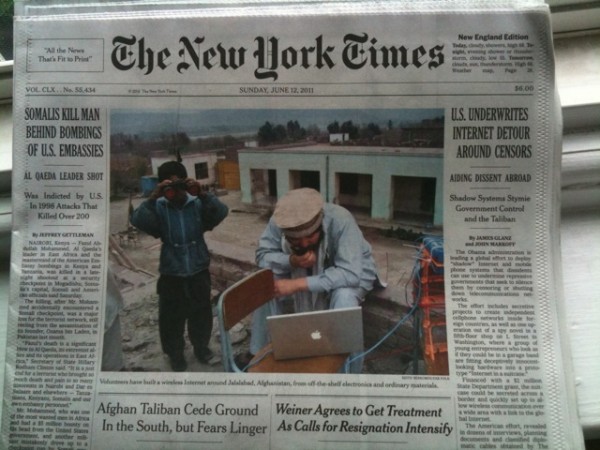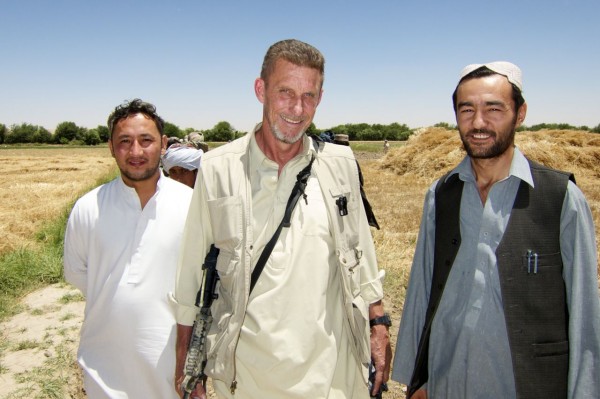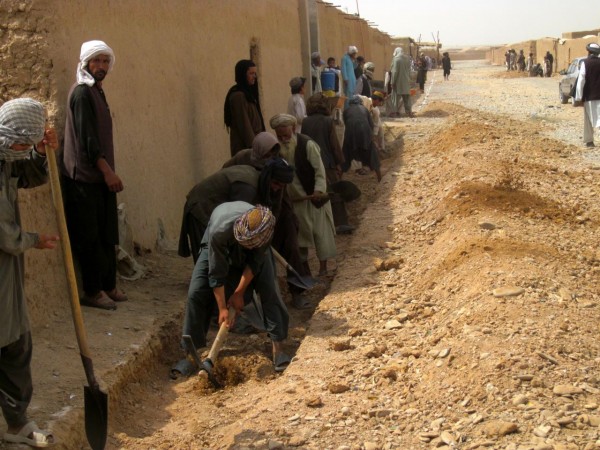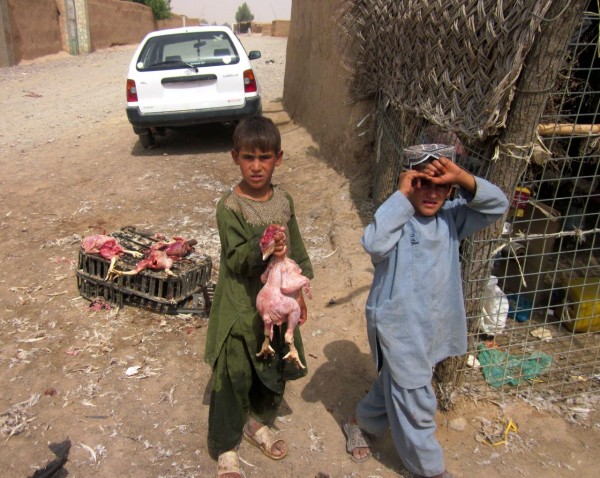Here’s an update in an attempt to counteract the thoroughly depressing news of Tim going silent. (Anyone who knows Tim in person knows that you can’t actually silence him; he’s still ranting but we’ve turned off the blog-mike). With Kanani’s help, I’ve put this post in Babatim format.
This weekend’s New York Times has several photos of FabFi Afghanistan in this piece on subversive community communication networks. (We’re in the slide set). To be clear, the FabFi project in Afghanistan was not one of those secretly funded projects described in their article (see here where I itemize the bulk of the costs and how they were funded – mostly through personal savings accounts of those who participated and in part through a National Science Foundation grant.) However, the urgency and significance of the project are the same. As long as there’s pressure from those seeking a reasonable life where they can go about their business, there’s hope we can throw a lifeline with these so called undermining capabilities.

< Insert non-sequitur rant about donkeys and hearing crickets. >
As the director of the Jalalabad Fab Lab and Fab Fi project lead, I’ve been asked several times about how to scale the Fab Lab and Fab Fi experiences to more fully saturate a city, as well as spinning this off into more cities. While I can provide a technical, programmatic answer, Fab Lab/Fi doesn’t solve everything. It’s only one piece: the rest have to develop at the same time. Infrastructure like roads, power, water, schools, teachers, and systems maintenance as well as the user terminals (laptops and computers), people who use them, and the content they’ll consume. It’s crazy to think that there was no cell phone service in the country in 2002 and now it’s pretty solidly working in every major population center (at least when the tower isn’t turned off or bombed). From roads to power to water, the task at hand (officially US or not) was to set off a program that could go from zero to servicing 30 million people in a few years. Imagine colonizing Mars by sending 30 million people first, ahead of the infrastructure. < Insert photo of BabaTim on Mars >

I think there are maybe three kinds of places in Afghanistan:
1. There are safer, quieter places that have known better times and whose residents are working to get back to those better times. There’s still crime and killing but it’s a shocking event when it occurs. 2. Poor, forgotten places that have never known modernization and are harder hit by economic problems (some of which we’ve unwittingly caused). 3. Places like Kandahar with an almost insidious infestation of crazy. Remember those boys you grew up with that would pull the wings off of bugs and set ants on fire? Beliefs aside, an environment like Kandahar doesn’t provide the social pressure that prevents them from growing up into full fledge people-hurting psychopaths.
In the first group are cities like Herat, in the western sector of Afghanistan. BabaTim went to Herat in 2005, and since then it’s continued to grow. It’s plainly ready and asking for a Fab Lab and associated wealth of possibilities. You could imagine a Fab Lab and Training Center there augmenting and strengthening the communications infrastructure with a parallel or overlaid subversive mesh, perhaps through the school system which I hear is quite healthy and respected.
The second group of towns, like Jaghori in Ghazni province, need only to follow the good examples of the first so much the better if there is strong municipal leadership that both welcomes business activities while keeping them in check < insert Big Government vs. Liberal rant here >.

The third are places like Kandahar, which is our biggest opportunity. Mel King, famous community organizer in Boston, often says that the wheels in the back of the bus never catch up to the wheels in the front unless something extraordinary occurs. Fighting over raisins, road tolls, heck, fighting over fighting, these are the things that they know about. New doesn’t always mean good on it’s own right, but in this case new can simply bewilder long enough for the skinny gimpy-legged kid to grab the football and run. Mixed metaphors, I know. It’s late. Another recent article from educators highlights how the labs are excuses to try something new with rewarding results.
In a recent round of catch-ups with the Afghan collaborators who helped start Fab Lab and the Fab Fi projects in Jalalabad (many of whom were university students when we met), I’m thrilled to tell you that all are gainfully employed in technically enabled positions. A (surprising?) majority have taken the plunge to starting their own technology, logistics, or consulting companies, bravely negotiating the bewilderingly paperwork intensive contracts with ISAF and providing jobs to Afghans. I believe in the need for the private sector to create jobs. < Insert anti-union rant here, take non-related pot shot at Anthony Weiner >

With the depressingly slow rate of new job creation at home in America, it’s hard not to be extra proud and amazed at their optimism and willingness to give it a go and make forward progress in their little corner of the world. I won’t take credit for their success they were shaped by a long chain of parents, family, teachers, and other opportunities but at least one was nice enough to say that it was his experiences of previously unexpected self-enabled successes in the Fab Lab that was his inspiration.
ps – join me in whining at Tim san to add some unrelated but interesting photos to this wordy piece. Thanks to edits by Kanani Fong of the Kitchen Dispatch.



Ahhhhhhhhh.. the blog does live — ! excellent@! go fabfi!
yea, no shit.. the article reads like you cats are funded to the tune of $50 to $250 million.. what a crock.. — ive been blasting all over facebook that this article is very well un researched !–
Really and truly, I miss BabaTim’s free enterprise rants, as well as figuring out how he would have worked in an Anthony Weiner jab. I miss the photos that would often extend over the borders of the blog.
Glad you got your words in. NY Times used 3 photos out of 7 to illustrate a story that was garbled at best. FabFi wasn’t set up to what the NY Times sets out to describe in the first paragraph: “The Obama administration is leading a global effort to deploy shadow Internet and mobile phone systems that dissidents can use to undermine repressive governments that seek to silence them by censoring or shutting down telecommunications networks.”
This story is very confusing, and from my understanding, the projects were in existence before any of the present uprisings in the middle east, or the problems with connectivity existed in the context of the current regime over throws anywhere. FabFi was not set up with the intent of providing a network that could be use to subvert governing bodies.
yeah. well. NYT photo desk contacted us about the use of specific photos they’d found on the web and described the context in which they would be used (a piece on community mesh wireless). We didn’t know the tenor of the piece or that it would be front page.
I suppose it’s a bit annoying that it implies we were one of the seriously sponsored/funded projects; and that they spent a fair amount of time describing a group that “is going to” build stuff that “will” connect things. But since they never actually talk about us in the article I guess they also didn’t say anything enraging 🙂
You’re right, neither of the networks in Afghanistan or Kenya were subversive in their intent, but simply pragmatic practice of technology hacking for and by those who don’t want to wait.
I looked at that story and there were at least 4 different writers, who knows how many editors and sources. It seems to me that they took one aspect of the current struggle in Libya, etc etc and then tried to apply the growth of technology to it.
Wow, nice photo!
who knew, the < insert rant here > tag commands Babatim to rant on command. Awesome.
Bravo Bravo! Excellent.
Most amazing.
The BabaTim rant on command discovery that is.
…
don’t think I’ll be trying that at home though…
My insurance clearly states, “No marine usage.”
LITERALLY,
R
Yeah, the NY Times definitely has to be put in check sometimes. When the Erik Prince in the UAE story broke out, there were tons of mistakes in it. There have been two corrections that have come out on that story since then.
The other thing about this story that raised my eyebrows was the fact that they have yet to secure the cell towers? That should have happened a long time ago, and a ‘shadow cellphone network’ would have been very helpful. The Taliban should not be allowed to manipulate the system or exert any authority over it.
As the old saying goes, it’s not what they say about you – it’s whether they spell your name right. Maybe someone will seek out FabFi in an effort to subvert it with real Money (capital ‘M’) but for now it remains an effort by geeks for geeks (those who have the latent geek gene, anyway). And Tim, wherever you are, I’m pretty sure FabFi was at least 50% designed by liberals. Fighting about fighting, American style.
Has FabFi any hope to move North into Kunar?
Over the past few years I have come to trust FRI. WE need the posts from Afghanistan that you provide. I do not want you to put yourselves in danger, but you are providing critically important information to many people here in the U.S.
If you can safely continue your work, please do so!!
Awesome. I was gutted when Tim stopped writing. Thanks for taking up the mantle Amy.